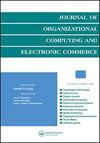Isn’t it about time to meet DORA?
IF 1.9
4区 管理学
Q3 COMPUTER SCIENCE, INFORMATION SYSTEMS
Journal of Organizational Computing and Electronic Commerce
Pub Date : 2018-10-02
DOI:10.1080/10919392.2018.1522774
引用次数: 1
Abstract
Given that DORA is rarely mentioned in scholarly journals devoted to the information systems (IS) field, it is likely safe to say that most contributors to, and users of, this and other IS journals are unfamiliar with DORA. Although the same holds for other functional areas of business, the situation is quite different in scientific and medical disciplines. Just maybe, these disciplines are onto something – something that could benefit ongoing development and recognition of IS as a discipline. So, what is DORA? Should we care? Why? The answers are important for shaping the development/future of IS as a scholarly discipline, encouraging/facilitating innovation in IS research, allowing/fostering research liberty for young IS scholars, and spurring a productive academic career that avoids disillusionment. Before addressing the questions, think about the state of approaches to evaluating researchers for merit, promotion, tenure, or funding purposes. Disregarding intrusions of organizational politics and personal relationships (which can be quite vexing to those on the short end of power), it seems typical to focus on where a researcher has published his or her work. It is most common for evaluation to focus on placement of articles in journals. This is usually the case for IS, other business disciplines, physical sciences, live sciences, and medical fields. Simply put, the value of a publication is considered to depend primarily on the journal in which it appears. In other words, the value of a gift is considered to depend on judgments about the wrapping that contains it, rather than the nature or utility of the gift itself (Zhang, Rousseau, and Sivertsen 2017). If it has a particular wrapping, then it must certainly be of the highest value. It follows that, if packaged in a different type of wrapping, that very same gift must be less valuable. Adopting such a method for evaluating a researcher’s work means that an article is judged to have less/more merit if it appears in one journal rather than another. Being in one journal versus another somehow diminishes/improves an article’s merit. The article is perceived as becoming imbued with a halo that a journal exudes, and that halo is seen as defining the article’s value. Adopting the halo method of research evaluation transforms the problem from one of assessing the merit of individual articles to the task of assessing the merit of individual journals (i.e., the strengths of their halos; the shininess/aesthetics/approval signaled by the wrapping papers). To support the efforts of evaluators, various approaches have been advanced/adopted for settling on the relative merits of journals in a field. Ultimately, it is the evaluator (or evaluator’s superiors) who selects what journal evaluation approach will be used in a halo exercise. Approaches range from largely subjective to largely objective. Comparative examples of various evaluation approaches can be found in a series of quizzes that are applied to the context of IS journals (Chen and Holsapple 2013). In the subjective case, the degree of strength attributed to a journal’s halo is determined by the evaluator’s (superior’s) vantage point, perspective, interpretations, preconceptions, training, biases, values, and so forth. Examples include relying on tradition, accepting pronouncements by others, or tailoring that accounts for journals that specialize in topics of particular emphasis by an institution or funding agency. In an effort to mitigate drawbacks of subjective methods, more data-driven methods to assess journal merit have been devised, applying various techniques to various kinds of data sets in order to produce: ● a numeric rating for each journal of interest, reflecting the strength of its halo ● a classification of journals into tiers, where the journals in a tier have comparable halos, but differ notably from those in other tiers. JOURNAL OF ORGANIZATIONAL COMPUTING AND ELECTRONIC COMMERCE 2018, VOL. 28, NO. 4, 287–290 https://doi.org/10.1080/10919392.2018.1522774是不是该见见多拉了?
鉴于DORA很少在专门研究信息系统(is)领域的学术期刊中被提及,可以肯定地说,本杂志和其他is期刊的大多数贡献者和用户都不熟悉DORA。虽然这同样适用于其他业务职能领域,但在科学和医学领域的情况却大不相同。也许,这些学科是在做一些事情——一些可以有利于IS作为一门学科的持续发展和认可的事情。那么,DORA是什么?我们应该在意吗?为什么?这些问题的答案对于塑造信息系统作为一门学术学科的发展/未来、鼓励/促进信息系统研究的创新、允许/培养年轻的信息系统学者的研究自由,以及刺激富有成效的学术生涯、避免幻灭都很重要。在回答这些问题之前,考虑一下评估研究人员的能力、晋升、任期或资助目的的方法的现状。不考虑组织政治和个人关系的干扰(这对那些处于权力短线的人来说是相当恼人的),关注研究人员在哪里发表了他或她的工作似乎是典型的。最常见的评估是关注文章在期刊中的位置。这通常是信息系统、其他商业学科、物理科学、生命科学和医学领域的情况。简单地说,一篇文章的价值主要取决于发表它的期刊。换句话说,礼物的价值被认为取决于对其包装的判断,而不是礼物本身的性质或效用(Zhang, Rousseau, and Sivertsen 2017)。如果它有一个特殊的包装,那么它肯定是最高价值的。由此可见,如果用不同类型的包装,同样的礼物一定不那么值钱。采用这种方法来评估研究人员的工作意味着,如果一篇文章出现在一个期刊上,而不是另一个期刊上,那么它就会被判断为具有更少/更多的价值。发表在某一期刊上与发表在另一期刊上相比,在某种程度上削弱/提高了一篇文章的价值。这篇文章被认为充满了期刊散发出的光环,而这种光环被视为定义了这篇文章的价值。采用光环法进行研究评价,将问题从评估个别文章的价值转变为评估个别期刊的价值(即其光环的优势;包装纸发出的光泽/美感/赞许)。为了支持评价者的工作,已经提出/采用了各种方法来确定一个领域中期刊的相对优点。最终,是评估者(或评估者的上级)选择在halo练习中使用哪种期刊评估方法。方法的范围从很大程度上主观到很大程度上客观。各种评估方法的比较例子可以在应用于IS期刊背景的一系列测验中找到(Chen和Holsapple 2013)。在主观情况下,归因于期刊光环的力量程度取决于评估者(上级)的有利位置、观点、解释、先入为主的观念、培训、偏见、价值观等。例子包括依赖传统,接受他人的声明,或者为专门研究某个机构或资助机构特别强调的主题的期刊调整账目。为了减轻主观方法的缺点,已经设计了更多的数据驱动方法来评估期刊的价值,将各种技术应用于各种类型的数据集,以便产生:●对每个感兴趣的期刊进行数字评级,反映其光环的强度●将期刊分为几层,其中一层中的期刊具有可比较的光环,但与其他层中的期刊明显不同。组织计算与电子商务学报,2018年第28卷,第2期。4,287 - 290 https://doi.org/10.1080/10919392.2018.1522774
本文章由计算机程序翻译,如有差异,请以英文原文为准。
求助全文
约1分钟内获得全文
求助全文
来源期刊

Journal of Organizational Computing and Electronic Commerce
工程技术-计算机:跨学科应用
CiteScore
5.80
自引率
17.20%
发文量
7
审稿时长
>12 weeks
期刊介绍:
The aim of the Journal of Organizational Computing and Electronic Commerce (JOCEC) is to publish quality, fresh, and innovative work that will make a difference for future research and practice rather than focusing on well-established research areas.
JOCEC publishes original research that explores the relationships between computer/communication technology and the design, operations, and performance of organizations. This includes implications of the technologies for organizational structure and dynamics, technological advances to keep pace with changes of organizations and their environments, emerging technological possibilities for improving organizational performance, and the many facets of electronic business.
Theoretical, experimental, survey, and design science research are all welcome and might look at:
• E-commerce
• Collaborative commerce
• Interorganizational systems
• Enterprise systems
• Supply chain technologies
• Computer-supported cooperative work
• Computer-aided coordination
• Economics of organizational computing
• Technologies for organizational learning
• Behavioral aspects of organizational computing.
 求助内容:
求助内容: 应助结果提醒方式:
应助结果提醒方式:


